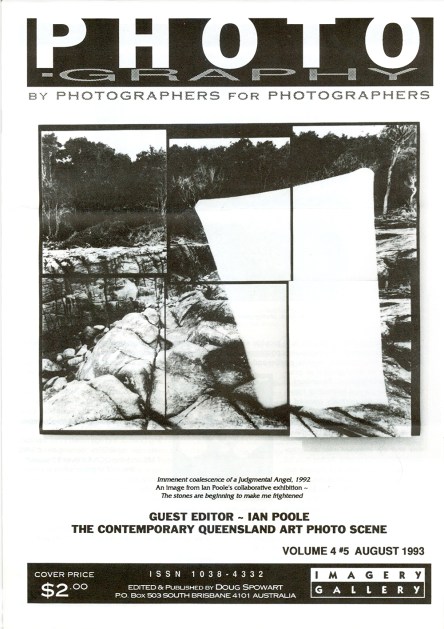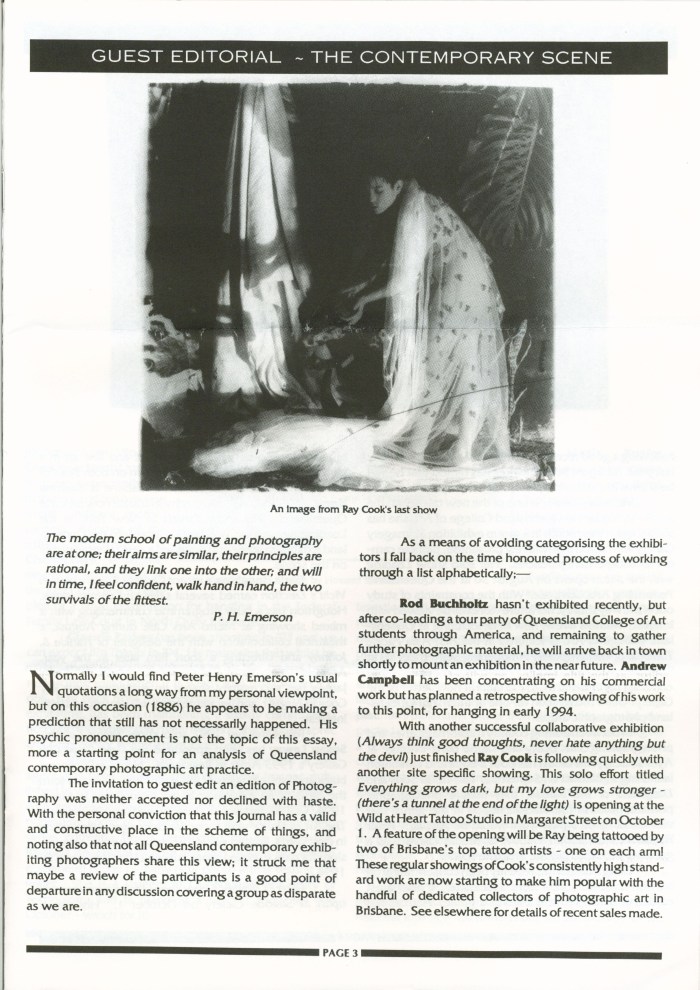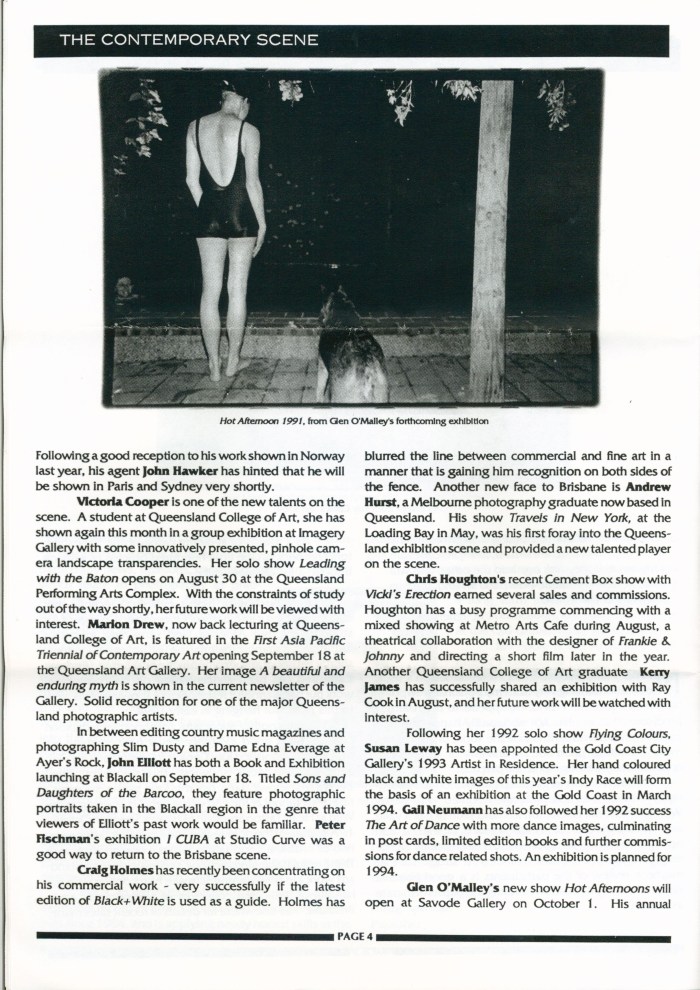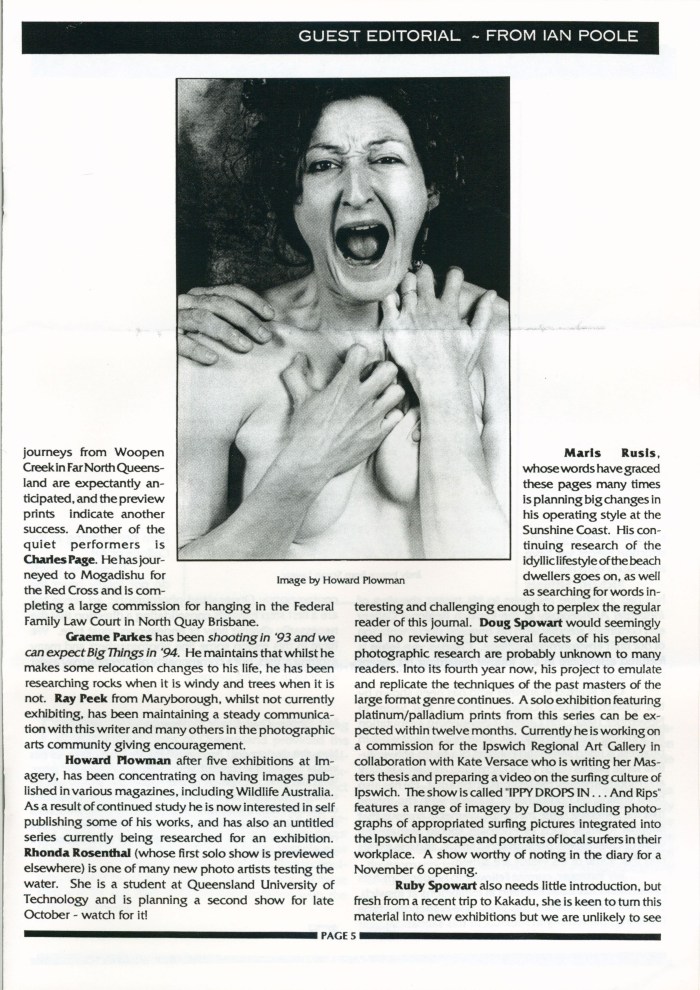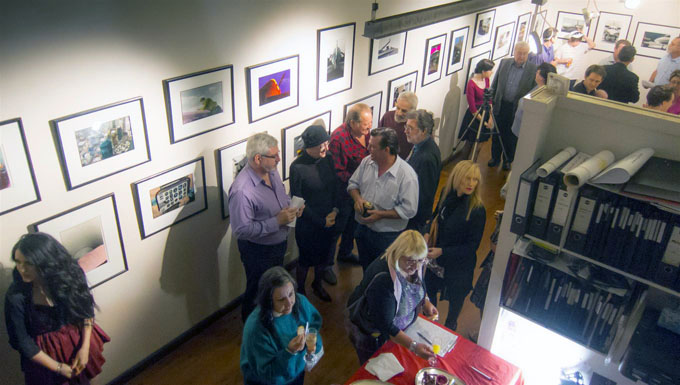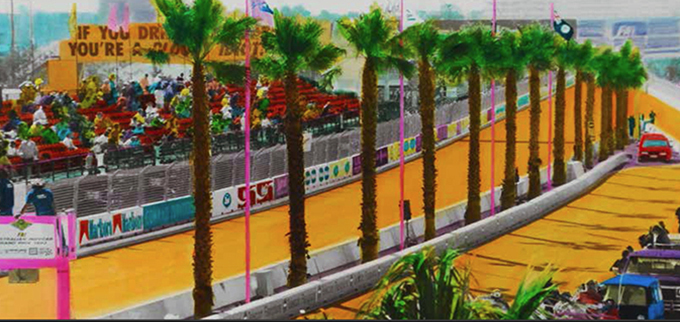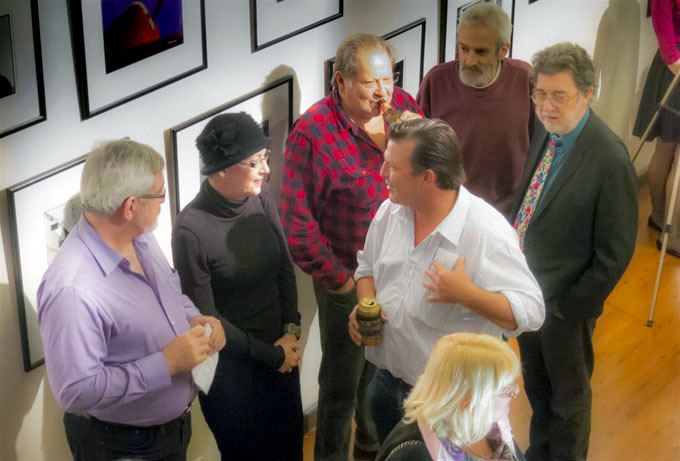Posts Tagged ‘Glen O’Malley’
1993 THE BRISBANE PHOTOGRAPHY SCENE: Ian Poole Guest Editor
From 1990 to 2001 I edited and published a journal called PHOTO.Graphy (ISSN 1038-4332 and earlier called ‘News Sheet’). This journal was created to fill a gap in the discussion, critique and commentary about a segment of the photography discipline within Australia. Occasionally I would engage guest editors to add their voice to the conversation. Ian Poole was the Guest Editor for Volume 4 #5 – Here is my Editorial introducing to Ian’s view of the art photography scene in Queensland in 1993.
Ian’s survey of the Queensland art photography scene makes for interesting reading nearly 25 years on… Mentioned in the survey are; Rod Buchholtz, Andrew Campbell, Ray Cook, Victoria Cooper, Marion Drew, John Elliott, Peter Fischman, Craig Holmes, Andrew Hurst, Chris Houghton, Susan Leway, Kerry James, Gail Newmann, Glen O’Malley, Charles Page, Graeme Parkes, Ray Peek, Howard Plowman, Rhonda Rosenthal, Maris Rusis, Doug Spowart, Ruby Spowart, Richard Stringer, Carl Warner, Jay and Younger. Charles A. von Jobin is also featured in the issue.
.
A PDF of the full issue is available HERE: PHOTO.G-Vol4n5r.
SUSAN LEWAY’s Show: Linear Acceleration – from Glen O’Malley
.
.
.
The following is Glen O’Malley’s opening address.
This is an exhibition of mainly vintage, hand-coloured black and white prints from the 80s and 90s, by Brisbane artist Susan Leway.
A few Australian photographers were playing with hand colouring techniques at that time – the beginnings of a period that has since been described as ‘post photographic’. It was not the traditional hand colouring of the wedding studios, made to look ‘real’, but a more interpretative approach, produced to look ‘hand coloured’. Most of the new hand colourists were female – the likes of Micky Allen – who drew on feminist strategies, emphasising the personal and autobiographical with a social documentary basis.
However it may eventually be interpreted, Leway’s intentions were not so feminist, nor so obviously socially aware. She just loved big machines! In the catalogue of her 1994 exhibition as artist in residence at Indy on the Gold Coast, Doug Spowart wrote. “Hers has always been rather mechanical, with a bent towards the apparatus of flight. Cigar shaped fuselage, two bladed prop, clash of perspex and rivets along with the occasional brave young aviator. Always Leway’s photographs have been embellished with a layer of hand applied coloured dyes.
.
.
Now it seems there has been a change, but strangely, although the machines are ground based, there still pervades a whiff of octane and flight.”
Leway herself put it even more passionately in 1993, “Tension, Excitement, Heat and Anticipation are four words that spell Indy to me”
In these digital days, ‘Photoshop’ is often used, in everyday language, to imply some sort of dishonesty. When Leway made these images, it was simpler. Sure, there were photographic critics concerned with whether photography’s purity was compromised, but no one thought it was dishonest. She put paint on photos. Strangely, in a world now, where we are bombarded by both subtly, and brutally, altered images, the pictures in this exhibition still have an unusual strength – maybe because it’s real paint on the paper.
Spowart wrote in 1994, “This new offering of Leway hand-tinted work continues to challenge our perception of colour and representation. For these photographs are neither natural colour nor are they monochrome black and white. They are perhaps Lewaycolour as it is through her selection and application that the chromatic aspects of these images are determined. Through this deliberate colourization of a black and white base image, unimaginable colours, except those which are in the artist’s mind, can be selected, applied and juxtaposed.”
.
Leway’s current exhibition at Woolloongabba Art Gallery has been produced with the artist facing many difficulties. It is pleasing to see a few recent digital images, but the majority of the work is older images. They are as fresh, or even fresher, today. To repeat what Doug Spowart said in the Indy caralogue, thank you, Susan.
.
Glen O’Malley 2013
The exhibition ran for one week at Woolloongabba Art Gallery from 27 – 31 August, 2013.
.
.
“The pits were incredible – so much going on, the level of technology astounding. Everyone (the teams) were linked by radio, computers abounded, even the camera crews were linked together by their equipment.
Watching the crews perform their duties, I was amazed at the teamwork involved and the speed at which they executed them. Basically you have about six seconds to capture the action because by eight seconds the crews were back behind the barrier and the cars were gone.
I definitely had the feeling that the whole scene was something out of Ancient Rome’s “Circus Maximus”.
Susan Leway 1993
.
.
ADDITIONAL PHOTOS from the opening…
.
Photos © Susan Leway, ©2012 portrait – Ian Poole, Exhibition photos by ©2013 Olive Lin and ©2013 Robert Ashdown and ©1994 portrait Doug Spowart
.
This text ©2013 Glen O’Malley is licensed under a Creative Commons Attribution-NonCommercial-NoDerivs 3.0 Unported License.
.
.
IAN POOLE: AIPP On the Lounge
Ian Poole is well placed to have an opinion about fine art photography and collecting photographs. He has been a major player in professional photography in Brisbane for nearly 40 years and is a respected AIPP judge with yearly invitations to also judge the New Zealand Institute of Professional Photography awards. Despite his professional photography connection he has been a part of a sector of the Queensland photographic art scene that extends from the early 1980s with Imagery Gallery, later with the Photographer’s Gallery and more recently with the Queensland Centre for Photography. He has completed a Graduate Diploma in Visual Arts from the Queensland College of Art and has been awarded an Australia Council residency in Tokyo. Adding to this he has curated photographic exhibitions in Japan (of Queensland photographers) and exhibitions in Australia (of local and Japanese photographers).
So when Poole offers commentary on aspects of the photographic art world of Brisbane and Queensland it should be something of an opportunity to connect with his extensive knowledge of the genre. Recently as part of the AIPP ‘On the Lounge’ lecture series Ian Poole presented to an assembled audience of around 40 a dissertation entitled, ‘Have you ever wanted to collect photographic art, or be collected as a photographic artist?’
Ian Poole began his presentation by reviewing recent art auction records for photographic artworks including those by Adams, Sexton and Dupain. Thousands, hundreds of thousands and even millions will change hands for well-known and rare works. The recent phenomena of Nick Brandt’s African work,which had been shown only weeks earlier in Brisbane, attracted some discussion. Perhaps some in the audience felt a little inspired by the possibility that, if they could enter the fine art field, that there was recognition and the possibility for a significant income to be made.
Poole introduced his collection of images that were hung on the walls and laid out on tables before the audience and discussed their histories and stories. For him the concept of ‘provenance’ elevated the importance of each work. A small Dupain image of the interior of the National Gallery in Canberra made during its construction was linked to his encounter with the work in a Brisbane gallery where it was purchased for a few hundred dollars. His most exuberant discussion related to a Joachim Froese diptych acquired when he swapped it with Joachim for a 4×5 enlarger. An expanded provenance trail led to it being loaned back to Joachim so that it could be displayed a QUT exhibition of his work.
A long-term friendship with north Queensland photographer Glen O’Malley presented some interesting provenance stories. O’Malley is not fully recognised for the significance of his practice in Queensland – he could probably claim to have had the first ‘photographic art’ exhibition in this state in the mid 1970s. Poole presented to the audience an image from O’Malley made as part of the Queensland Art Gallery’s 1988 Journeys North commission. The 20×24” black and white photograph showed a scene in Poole’s home where the O’Malleys were having dinner. The image was part of the accepted images for the Journeys North show and was subsequently published. Somehow Poole’s own life had become art photography itself.
Another photography collaborator presented by Poole was John Elliott. Well known for his documentation of country and western music and its heroes and doyens including Slim Dusty, Chad Morgan and Jimmy Little, Elliott is an enigmatic character of the photography scene. Ian spoke of John’s most recent show Gifted Country at the Caboolture Regional Art Gallery and his photobook publishing ventures. A recent journey to Townsville that Poole had shared with another of Queensland’s enigmatic photographers, Maris Rusis, resulted in a body of work by Rusis that dealt with the décor of budget north Queensland motel rooms. These small and fine gelatin silver fibre B&W prints presented to the audience the fact that traditional values remain key to some workers who continue to practice analogue photography in a digital world.
Question time brought up some difficult truths – Why does the Queensland Art Gallery/GOMA not seem to be collecting photography generated within this state? Did they ever collect? Some discussion related to the archival needs for conservation framing and presentation.
As a conclusion to the presentation Poole spoke of the way in which he and his photography acquaintances swapped and shared their works, and how much of his collection was built around the generosity of fellow photographers and their desire to share. He held a bundle of his own gelatin silver images up before the audience and made an offer that ‘you can have one of my prints this evening – and send a print to me as a swap. Start your collection this evening …’
While Ian Poole began his presentation with a review of the overtly mercantile auction scene, it seemed that his passion about photography, photographs, friends, shared experiences and the meaningfulness of the provenance of the works, that these things could not be commodified. He spoke of his collection of photos, books and ephemera as being an entity that would be bequeathed to his daughter Nicola, also a photographer and present at the talk. Through the audience he directed to Nicola to ‘treasure and look after these things … they were important, valuable – not only as the stories they depicted through their image on the front-side of the print, but also of the back-story of their origin and collection.’
There is no doubt that Ian Poole’s passion for photography and his understanding of how it operates at a personal and cultural level is something that was shared and communicated on this evening. And those present will be inspired to develop a new appreciation of what photographs are and what they can say about the human condition.
Doug Spowart May 20, 2012
An unusual meeting – Face-to-Face with an early portrait of one’s self – circa 1982 found in Poole’s collection
GLEN O’MALLEY visits Toowoomba April 12+13, 2011
Significant Queensland documentary photographer Glen O’Malley visited Toowoomba over the last few days to catch up with old friends and acquaintances. On the evening of April 12 he made a presentation and showed recent work to students from the Southern Queensland Institute of TAFE.
Glen is one of Queensland’s great photography characters. Well known for his street documentary photographs which go back to the earliest days of ‘art photography’ – his first solo exhibition was held in 1975. Coming from way up north, near Babinda, Glen has for years been a master of traditional black and white. In recent years he has ‘crossed over’ to the digital and that has opened up a whole new vision for him – one that is very coloured. Originally trained as an artist Glen considers his ‘colourist’ background has re-emerged in his digital capture.
Another aspect to the O’Malley style is that he is a surrealist. Images in recent exhibitions ‘Hotplate Heaven’ and the ‘Pet Show’ feature prosaic home environments which are inhabited by ordinary looking people who do the most bizzare things. His latest work for a new show at the Queensland Centre for Photography in June. The exhibition is entitled ‘What a night!’ and features not only his own work but also images by Kellie White.
 Students viewing Glen and Kellie’s works
Students viewing Glen and Kellie’s works
Glen and Kellie’s work feature images made at night or dusk with flash or torch work illuminating the subject. Technique is one thing but the images are something else – they are, as you might expect, surreal but there is more! The images appear as spontaneous, serendipitous and intuitive moments. Intrigue and mystery are embedded in each image and do demand intense and prolonged viewing
Some of Kellie’s images
Some of Glen’s work
Written by Doug Spowart
